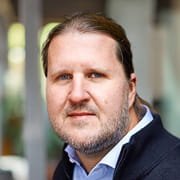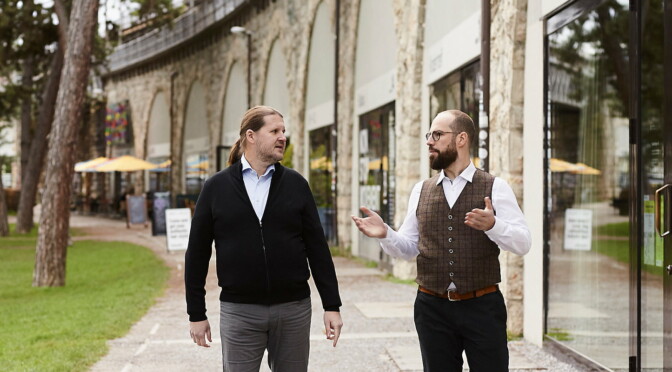In the fast-paced IT world, it is almost impossible for IT decision-makers and developers to keep track of all relevant or new technologies and trends. That is why international market research and consulting companies, like Gartner or Thoughtworks, map global technology developments using trend barometers.
“However, these global trend barometers are not always as relevant for Swiss SMEs. In order to take account of the Swiss market too, we developed the Technica Radar”, explains Marco Ravicini. He along with Axel Hohnberg and Patrick Labud are members of the CTO Board of bbv Software Services and together they are responsible for developing and creating bbv’s Technica Radar.
The Technica Radar gathers the latest developments in IT, reflects expert opinion and reproduces studies and recommendations from market research companies or the federal government. By focusing specifically on the Swiss market and the needs of SMEs , the Technica Radar sets itself apart from other international trend barometers.
This makes the Technica Radar a pragmatic tool for IT decision-makers and software developers in Switzerland. The aim of collecting and preparing the information is to support decision-making and provide a basis for discussion in SMEs.
The Technica Radar 2023 is already the third edition of the practical tool, with the first two editions appearing in 2021 and 2022.
Evolution rather than revolution: No game changer in sight
The Technica Radar is more than a collection of technical information. Apart from listing trends, it also classifies them and explains which developments companies should keep an eye on and why.
“The Technica Radar focuses on current developments, but it is also a versatile decision-making tool. Regardless of whether you want to classify a particular technology, a framework or a programming method, or simply want to know which technologies to watch out for now and in the near future”, explains Patrick Labud.

Patrick Labud and Marco Ravicini currently see no disruption looming. “The entire development is more evolutionary at the moment, there is no sign of any technology revolution that will deliver absolute game changers”, says Marco Ravicini.
Cloud-specific approaches, such as edge computing or infrastructure as code (IaC), are becoming increasingly important, as is systemic thinking, which is reflected in methods such as system thinking or value stream mapping. bbv’s CTO board is following the metaverse topic with interest, but does not consider it relevant as yet for the current radar.
These IT topics will be trending in 2023
Evolution rather than revolution: This applies to most of the topics identified by bbv’s Technica Radar. For example, there is no way around topics like security engineering and edge computing in Switzerland at the moment. But what about Ethical OS and programming using AI? bbv presents the upward trends from the Technica Radar 2023.
Edge computing is still on the ascent because of its association with IoT and cloud computing. “This is where the typical IT evolution can be seen: Big topics generate and, in turn, necessitate new big topics”, says Patrick Labud. In addition, edge computing is also becoming increasingly important in connection with AI and data science.
Because edge components are neuralgic points, they are ideally suited to complex systems for optimising data volumes or complying with data protection. “For example, we developed an edge protection solution for clinical algorithms, with which only the results of gene analyses are forwarded, but not the gene indicators”, says Labud.
Due to this filter at the edge of the network, it is not possible to reconstruct sensitive or privileged information on the recipient side.
The API-first approaches of the public clouds allow infrastructure to be created and changed automatically. In the infrastructure-as-code approach, the entire infrastructure is modelled as code and then created with tooling. This allows new infrastructures to be created or existing infrastructures to be updated as part of continuous deployment and adapted to new requirements.
IaC makes it possible to keep a constant grip on the infrastructure as it becomes increasingly complicated. It enables teams to deploy their public cloud infrastructure faster and with fewer risks. Although IaC requires a certain amount of effort, this can already pay off through use in multiple environments such as development, testing and production.
Looking ahead, the emerging trend of the distributed cloud is dedicated, among other things, to the challenges of maintaining distributed, more complicated infrastructures.
Cyber threats are becoming increasingly complex and demand new protective measures. “You won’t get far these days with the motto ‘It’ll be fine, we’ll just do it this way’”, says Patrick Labud. With security engineering, security is defined as early as during software programming.
The principle of “Security by Design” states that security should be regarded as a quality attribute of software. Patrick Labud is convinced that security engineering is an investment that pays off: “Paying preventive attention to system security is better than plugging gaps afterwards or even repairing the damage caused by a hacker attack.”
Specifically, security engineering means that security is considered in the entire software engineering cycle. For example, by means of threat modelling or the Zero Trust approach, which assigns users only as many rights as they really need.
Security engineering also means that business-critical data is specially protected or that you do not rely on a single firewall in a system, rather create different zones or subnetworks behind it.
With the system thinking concept, companies, digital environments or software development are viewed as a system – and increasingly also referred to as socio-technical systems. System theory as a scientific branch has its roots in 20th century sociology and political science, but is currently experiencing a renaissance.
“Methods such as value stream mapping help identify idle times, waiting times and blind alleys so as to optimise the flow of decisions or processes”, says Patrick Labud. The demand for such analyses is also increasing because of the availability of new tools, which allow corresponding visualisations to be carried out.
“We often use value stream mapping in transformation projects or software architectures and try to consistently eliminate non-meaningful elements between the initial state and the target state throughout the product development process in the entire company”, says Labud.
The method helps to identify the optimisation potential of a development team.
Digital technologies promise to improve the work and everyday lives of people and companies. But they can also be misused: This is how misinformation and incitement flood social networks or drones spy on neighbours instead of delivering a package.
“The question as to whether and why a technology can be misused is often lost in product development due to enthusiasm about the new feature”, says Patrick Labud. The Ethical OS framework was developed in order to also tackle such questions. It helps to identify problem areas and risks, assess the negative consequences of innovations more easily and prevent moral quandaries.
“Ethical OS helps companies to take responsibility and anticipate consequential damage, so that they do not regret the development of their products and services in the future”, adds Labud. However, Ethical OS not only deals with the negative consequences, it can also highlight the positive benefits of a technology.
Patrick Labud is convinced that “Many companies are becoming software companies and do not even notice it”. What he is referring to here is the merging of business and IT strategy. In other words: The technology within the company is becoming business-relevant, while the actual products are becoming secondary.
“Insurance companies are IT companies today”, says Labud, “and carmakers like VW are also undergoing the same transformation.” This development is paraphrased by the term “strategy engineered”. Business and IT thus become merged so that they no longer function as two separate areas.
While the business strategy always did influence the IT strategy and vice versa, the fact that software development can suddenly become core business is new. If IT and business strategy are harmoniously interwoven in the sense of strategy engineered, then products or services can be developed and offered competitively.
Blazor is listed as an upward trend in the tools category in the Technica Radar. Introduced in 2018 by Microsoft, the solution has become a popular tool for rendering web applications alongside JavaScript-based frameworks (like Angular or React) and is likely to continue to grow in importance.
“Use of blazor appears to be a valid option especially in teams that are heavily involved with the .NET ecosystem and have no experience in the JavaScript ecosystem”, concludes Labud.
Creative image generators based on AI have been a household name for a wider audience since Dall-E 2 or Stable Diffusion. Such approaches also exist in software development. Apart from Microsoft (GitHub Copilot) and Amazon (CodeWhisperer), there are also products, such as Tabnine or Captain Stack, which offer an AI pair programming solution.
The reactions of the community to these developments were very different. Software development based on AI can be an opportunity to learn about alternative and possibly better performing code and build on it. It also offers potential to write non-business-related code faster.
However, the danger is that code can be generated with hacks based on the training set of the model. AI tools should therefore not be used without engineering practices like TDD.
Another hurdle for this technology is certainly the current case against Microsoft, GitHub and OpenAI.
Members of the CTO Board of bbv

Patrick Labud
Patrick Labud has been working for bbv for more than ten years. He studied computer science and specialised in content and frontend systems as well as in the area of usability, user and customer experience and design thinking. These days, he mainly works as a consultant and spokesperson for human-centric digital product development. He is a founding member of the CTO Board, which has been in existence for seven years now and defines bbv’s technology strategy and publishes the Technica Radar.

Marco Ravicini
Marco Ravicini is a trained automation engineer and worked as a software crafter for many years after studying computer science. He, too, has been working for bbv for more than ten years. As a software architect, he is especially in demand when it comes to developing the architecture of systems – from concept to design to communication with customers. He holds an MAS in Human Computer Interaction Design.

Axel Hohnberg
Axel Hohnberg is Service Unit Manager and member of the CTO Board of bbv. By keeping a constant eye on the latest digitalisation trends, he ensures that bbv employees have the right know-how to develop excellent IT solutions – and can support customers optimally when implementing their digital strategy.






